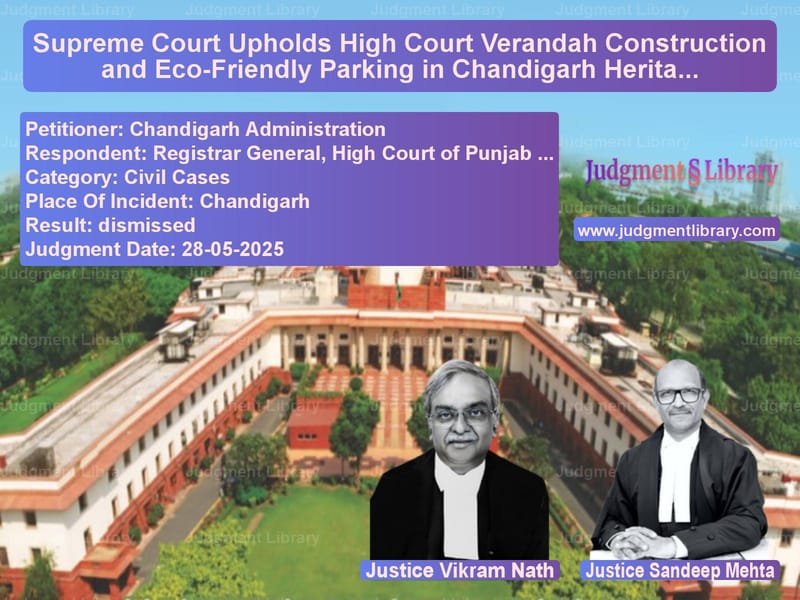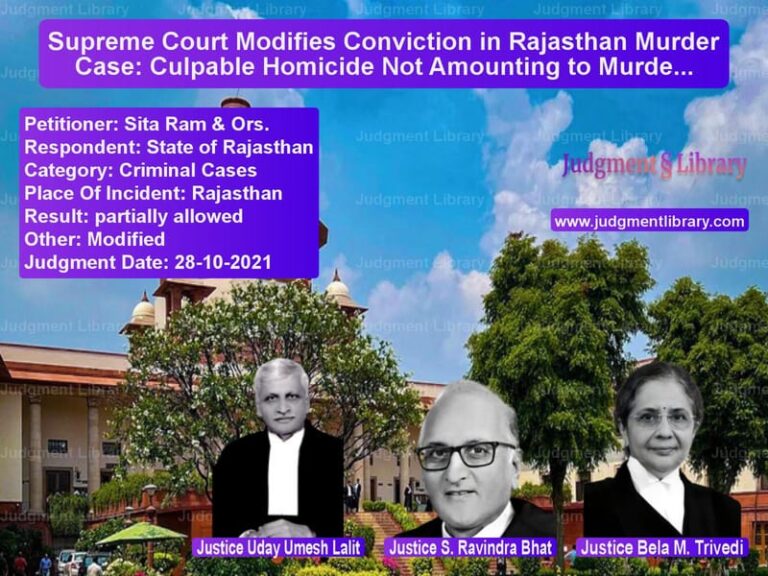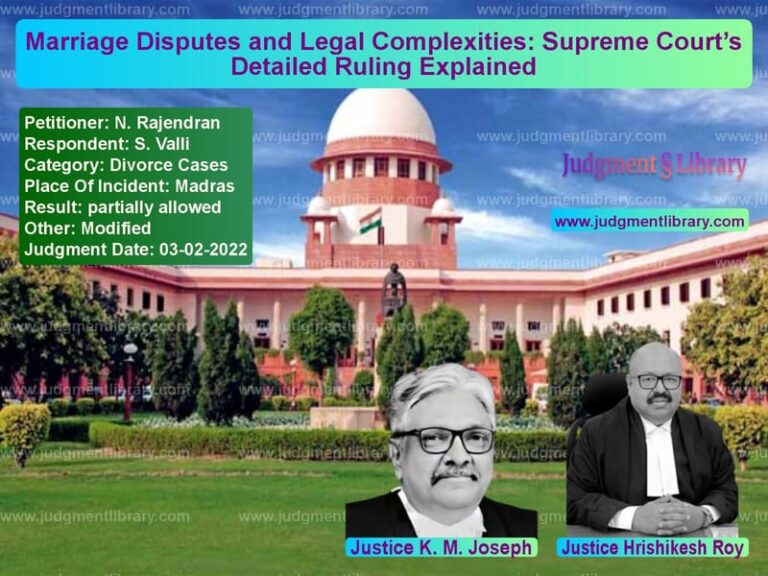Supreme Court Upholds High Court Verandah Construction and Eco-Friendly Parking in Chandigarh Heritage Dispute
In a landmark judgment that balances heritage conservation with practical necessities, the Supreme Court of India has upheld the Punjab and Haryana High Court’s directions for constructing a verandah and implementing eco-friendly parking solutions in the Chandigarh Capitol Complex, a UNESCO World Heritage Site. The case pitted the Chandigarh Administration’s concerns about preserving the city’s architectural heritage against the High Court’s need to provide basic amenities for lawyers and litigants.
The legal battle began when the High Court, through a series of orders in 2024 and 2025, directed the Chandigarh Administration to construct a verandah in front of Court Room No. 1 and lay green paver blocks in the parking area to address critical infrastructure needs. The Administration challenged these directions, fearing they might jeopardize the UNESCO World Heritage status of the Le Corbusier-designed complex.
The Supreme Court’s judgment, delivered by Justices Vikram Nath and Sandeep Mehta, represents a careful balancing act between preserving architectural heritage and meeting contemporary functional requirements. The Court examined two primary issues: the construction of a verandah in front of Court Room No. 1 and the implementation of green paver blocks in the parking area.
The Verandah Controversy: Heritage vs. Practical Needs
The Solicitor General of India, Shri Tushar Mehta, appearing for the Chandigarh Administration, presented the core concern about heritage preservation. He “vehemently and fervently urged that the administration does not have any quarrel in principle with the proposed construction of the verandah in compliance of the order dated 29th November, 2024 passed by the High Court. However, the administration is concerned with imminent possibility of the loss of World Heritage status of the Chandigarh Capitol Complex, which includes the Assembly, the High Court and the Secretariat, designed by the celebrated architect, Mons. Le Corbusier.”
Shri Mehta emphasized the international implications, stating that “the Chandigarh Capitol Complex which includes the High Court building, was designated as a UNESCO World Heritage Site in the year 2016 as a part of the Trans-Border Serial Nomination for the Architectural Works of Mons. Le Corbusier, which consists of 17 sites spread across 7 countries. As per the applicable guidelines, any proposed changes in the World Heritage Site are to be communicated to the World Heritage Committee, UNESCO in advance and their concurrence is to be sought, failing which, there is a risk of the site losing its World Heritage status.”
The Administration’s counsel was candid about their position, noting that “the CA is also alive to the situation that the open area in front of Court Room No. 1 of the High Court building is exposed to the elements. CA does not dispute the fact that litigants and lawyers who use this area have no protection from sun, winds and rain.” However, he urged for more time to “procure the requisite permissions” from UNESCO.
Supporting the Administration’s position, Shri P.S. Patwalia, learned senior counsel appearing as Amicus Curiae, revealed historical context that “the very same proposal was put up in the year 1956 when the then Chief Justice turned down the suggestion of the Superintending Engineer of the Capitol Project, Chandigarh to construct an additional verandah in front of Court Room No. 1.”
The High Court’s Defense of Practical Necessities
Shri Nidhesh Gupta, learned senior counsel appearing for the High Court administration, strongly defended the impugned orders. He argued that “the Court Room Nos. 2 to 9, which are in the same alignment as the Court Room No. 1, already have a pre-existing verandah which is 12 feet high and provides wholesome protection from sun, winds and rain, etc. to the stakeholders, i.e., the litigants, lawyers, etc. who frequent the High Court premises.”
Addressing the UNESCO guidelines, Shri Gupta submitted that “paragraph 172 of the Operational Guidelines only provides that any major restorations or new constructions which may affect the OUV of the property and are irreversible should be undertaken after due approval from the World Heritage Committee, UNESCO.” He contended that “the verandah proposed to be constructed cannot be said to be a permanent structure which cannot be removed. Hence, the additional verandah cannot be termed to be a structure which can never be removed and the decision is not irreversible.”
Gupta presented compelling historical evidence from “the letter dated 17th May, 1956 placed on record by the CA along with the additional affidavit dated 5th May, 2025 wherein it is clearly provided that the construction of the additional verandah in front of Court Room No. 1 similar to the verandah in front of the smaller Court Rooms i.e., Court Room Nos. 2 to 9 had been proposed by Chandigarh Administration and refers to a suggestion made by the Architect Mons. Le Corbusier.”
He argued that the 1956 decision to reject the verandah “was based on the personal perception of the Chief Justice and was a decision taken after consultation in the full Court. It is not such a decision which cannot be reviewed even on the administrative side. He submitted that the dynamics of Court functioning have altered significantly over the last 70 years, and the High Court administration felt a dire need to provide a verandah for the stakeholders.”
The Parking Dilemma: Environmental Concerns vs. Practical Realities
The second major issue involved the High Court’s direction to lay green paver blocks in the parking area. The Solicitor General argued that “this open area is part of the green belt under the Chandigarh Master Plan, 2031 and can be used for planting trees only and no deviation is permissible under the Master Plan. Shri Mehta urged that the importance of vertical greenery in the city of Chandigarh cannot be understated and if the green paver blocks as proposed in the impugned order dated 7th February, 2025 are affixed on this open space, the very character of the green belt area will be altered irreversibly.”
In response, Shri Gupta highlighted the practical realities, stating that “on any given working day, almost 3000 to 4000 vehicles of advocates, litigants and officials are being parked in the open area where the High Court has directed the laying of the green paver blocks.” He emphasized the environmental benefits of the proposed solution, noting that “by their very design, the green paver blocks merge with the natural surroundings and they allow rainwater to percolate into the ground. The significant advantages which would be gained by laying of such blocks are (i) eliminating the possibility of blowing of dust and sand because of frequent movement of the vehicles on the open area; and (ii) eliminating the possibility of formation of sludge and muddy surfaces during rainy season.”
The Supreme Court’s Balanced Approach
The Supreme Court conducted a thorough examination of the UNESCO guidelines, particularly paragraph 172 of the Operational Guidelines, which states that “The Word Heritage Committee invites the States Parties to the Convention to inform the Committee, through the Secretariat, of their intention to undertake or to authorize in an area protected under the Convention major restorations or new constructions which may affect the Outstanding Universal Value of the property. Notice should be given as soon as possible (for instance, before drafting basic documents for specific projects) and before making any decisions that would be difficult to reverse.”
The Court noted that “a careful and holistic perusal of the aforesaid guidelines would indicate that the OUV of the property is likely to be affected if major restorations or new constructions are attempted on the structure having World Heritage status. The guidelines give a clear indication that the decision should not be such ‘that it would be difficult to reverse.'”
Examining the historical evidence, the Court found that “the letter makes clear reference to the fact that the construction of an additional verandah in front of main Court Room, i.e., Court Room No. 1 similar to the verandah in front of the small Court Rooms was in consideration of the Government authorities way back in 1956. It is a different story that the then Chief Justice of the High Court proceeded to turn down the said proposal based on his personal perception without any collective discussion.”
The Court concluded that “we have no doubt in our minds that the construction of the verandah in front of the main Court Room i.e., Court Room No. 1 was being mooted by the Concerned Authority way back in 1956 and had the Chief Justice consented, the construction would have happened long back.”
Regarding the UNESCO compliance, the Court was “satisfied with the submission of Shri Gupta appearing for the High Court administration that even as per paragraph 172 of the Operational Guidelines, construction of the verandah in front of Court Room No. 1 in alignment with the pre-existing verandahs in front of the Court Room Nos. 2 to 9, would not violate the aforesaid guidelines because neither such verandah can be said to be a major restoration nor a new construction within the main structure of the High Court building.”
The Court provided a practical solution, noting that “the modern architectural techniques have progressed by leaps and bounds. New construction materials and techniques are available in the market which can be employed to construct a verandah in front of Court Room No. 1 exactly identical to the one which is existing in front of Court Room Nos. 2 to 9 without disturbing the aesthetic value of the main structure and without requiring any kind of modification/alteration in the main structure. The additional verandah can even be in the form of a collapsible/removable structure, if so required.”
The Court emphasized that “the High Court administration is best placed to take a suitable decision as to what are the precise requirements for preservation of the building and simultaneously provide protection to the stakeholders from the elements. It cannot be gainsaid that the High Court administration is under an obligation to provide appropriate facilities for the lawyers and the litigants who throng the Courts.”
Sustainable Development in Parking Solutions
On the parking issue, the Court drew upon established environmental jurisprudence, particularly referencing the case of Rajeev Suri v. Delhi Development Authority. The Court noted that “indubitably, environment and development are not sworn enemies of each other. It would be an anomalous approach to consider environment as a hurdle in development and vice-versa.”
The judgment emphasized that “as long as a legitimate development activity can be carried on in harmony with the idea of environmental protection and preservation including sustainable development, the Courts as well as expert bodies should make their best endeavour to ensure that harmony is upheld and hurdles are minimized by resorting to active mitigating measures.”
The Court recognized the practical necessity, stating that “it cannot be gainsaid that the requirement of a proper parking space for the lawyers and the litigants is imperative because the pre-existing facility in the High Court has fallen woefully short. It was meant to cater to 600 four-wheeler vehicles but reportedly, 3000 to 4000 four-wheeler vehicles access the High Court campus on any given working day, and the number is bound to rise with the passage of time.”
The Court found an elegant compromise, noting that “the green paver blocks are scientifically known eco-friendly alternatives for regular paver blocks because in the middle of each paver block, there is an empty space for planting grass, etc. The suggestion given by learned Solicitor General to plant trees on this open area can still be visualized by planting suitable number of trees at regular intervals in between the green paver blocks. This would simultaneously create a green cover on the ground and so also vertical green cover, thereby enhancing the overall ecological balance of the area.”
Conclusion and Directions
The Supreme Court ultimately upheld both the verandah construction and the green paver block implementation, while providing that “the contempt proceedings initiated vide order dated 13th December, 2024 shall be kept in abeyance for a period of twelve weeks so as to enable the CA (appellant herein) to comply with the order dated 29th November, 2024 passed by the High Court.”
This judgment represents a significant precedent in balancing heritage conservation with functional necessities. The Court demonstrated that with careful planning and modern architectural solutions, it’s possible to preserve architectural heritage while meeting contemporary needs. The decision emphasizes that heritage preservation shouldn’t mean freezing buildings in time, but rather adapting them sensitively to serve their intended purposes while maintaining their essential character and value.
The Supreme Court’s approach reflects a mature understanding that World Heritage status should facilitate thoughtful adaptation rather than prevent necessary improvements, especially when those improvements align with the original architectural vision and can be implemented using reversible, non-intrusive methods.
Petitioner Name: Chandigarh Administration.Respondent Name: Registrar General, High Court of Punjab and Haryana, Chandigarh and Others.Judgment By: Justice Vikram Nath, Justice Sandeep Mehta.Place Of Incident: Chandigarh.Judgment Date: 28-05-2025.Result: dismissed.
Don’t miss out on the full details! Download the complete judgment in PDF format below and gain valuable insights instantly!
Download Judgment: chandigarh-administr-vs-registrar-general,-h-supreme-court-of-india-judgment-dated-28-05-2025.pdf
Directly Download Judgment: Directly download this Judgment
See all petitions in Property Disputes
See all petitions in Environmental Cases
See all petitions in Public Interest Litigation
See all petitions in Constitution Interpretation
See all petitions in Judgment by Vikram Nath
See all petitions in Judgment by Sandeep Mehta
See all petitions in dismissed
See all petitions in supreme court of India judgments May 2025
See all petitions in 2025 judgments
See all posts in Civil Cases Category
See all allowed petitions in Civil Cases Category
See all Dismissed petitions in Civil Cases Category
See all partially allowed petitions in Civil Cases Category







